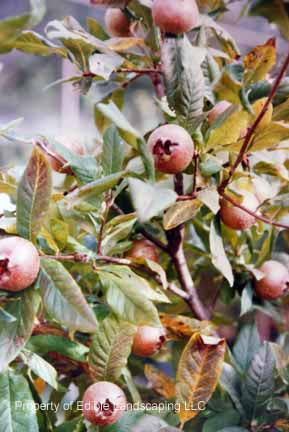
Mespilus germanica
Breda Giant's fruits resemble very, very large bronze rose hips. A relative of the pear, medlars are sometimes referred to as northern loquat because of their long green leaves with a leathery appearance. Breda Giant is self fertile, late blooming with showy white flowers and the tree is long lived and dwarf. Fruits are harvested firm, when leaves start falling in late fall. In warmer areas they can blet and ripen on the tree. Fruits can be stored to blet in clean shavings, boxed in a cool basement or porch. The flesh turns soft and has an applesauce cinnamon like flavor. Also called nespola in Italy. Fruits are bug free but can get quince or cedar apple rust. Space 8' circle Zone 5-9
| Plant Characteristics | |
|---|---|
| Pest Resistance | Excellent |
| Disease Resistance | Good |
| Drought Tolerance | Good |
| Heat Tolerance | Very Good |
| Humidity Tolerance | Very Good |
| Sun Tolerance | Very Good |
| Wet Soil Tolerance | Fair |
| Shade Tolerance | Fair |
| No Spray | Good |
| Fresh for Kids | Good |
| Deer Resistance | Fair |
| Thorns | No |
| Plant Type | Tree |
| Soil Type | Adaptable |
| Edible Type | Fruit |
| Self Fertile | Yes |
| This information is accurate to the best of our knowledge, comments/opinions are always welcome | |
Care Guide
The medlar is native to the eastern part of the Mediterranean and the eastern part of Turkey, the western part of Iran and around the Caucasus. The medlar came to Greece around 700 BC. Archilochos of Paros already mentioned the fruit. After the Macedonian Wars about 200 BC, it cam to Rome. Theophrastus and later Pliny already described three different types of medlars. It is found wild in Austria, mostly in Niederosterreich, up to 1100 meters, in Switzerland, France, Spain, Portugal, the Netherlands. It is depicted in mosaics in Pompeii. Charlemagne (768-841) mentioned the medlar as one of the trees which should be planted in the orchards of the Imperial Gardens. It also figures on the famous list of the St. Galler Klostergardens of 820. Under the influence of English garden architecture, park-like gardens came into fashion and in those gardens picturesque trees like the medlar were very welcome. The medlar is a fairly low tree, between 3 and 6 meters high, with a broad crown and heavy foliage which turns a beautiful reddish-brown in fall. Branches, and often even the trunk, are contorted. The leaves are long and pointed, about 12cm. long, hairy on the underside. And a mass of white, scentless flowers appear during the second half of May. The fruit is greenish-yellow when unripe; it looks a bit like an apple, but with an indentation on the top, surrounded by the calyces. Uses of the Medlar The most obvious use of a fruit-bearing tree is of course the consumption of the fruit. The medlar can be eaten raw, but only once it is bletted. Fruit is picked in late autumn and at that stage it is still very hard and greenish-yellow in color. When kept in a cool place,e.g. in layers of straw or sawdust, it will keep for many weeks, even months. During this time a process of fermentation will take place which changes the consistency of the fruit. It becomes soft to touch and brownish in color. At this stage it can be sucked empty, leaving the skin and stones behind. The consistency of the flesh is rather coarse with a very special taste to it, difficult to describe. Someone described it to me as eating coarse apple sauce with a large amount of cinnamon in it. Eaten when they are still hard they will pucker up your mouth, due to the tannic acid which is present in the fruit. In addition to being eaten raw, the fruit can also be used to make harvest wine or a cider. People also use to add it to their wine to give the wine the special medlar taste. Medlars could also be sugared. And of course they can be cooked and made into jelly very easily due to the high concentration of pectin in them. Since enzyme rich foods are becoming very popular, medlar may get some special attention. Of course it is not only the fruit which can be used. The medlar is a relatively slow-growing tree, which means that the wood is rather hard. In earlier days, this wood was used to make spearpoints, clubs and fighting sticks for the hunt and for warfare. Later on the wood was used for making parts of windmills, especially some of the turning wheels.

